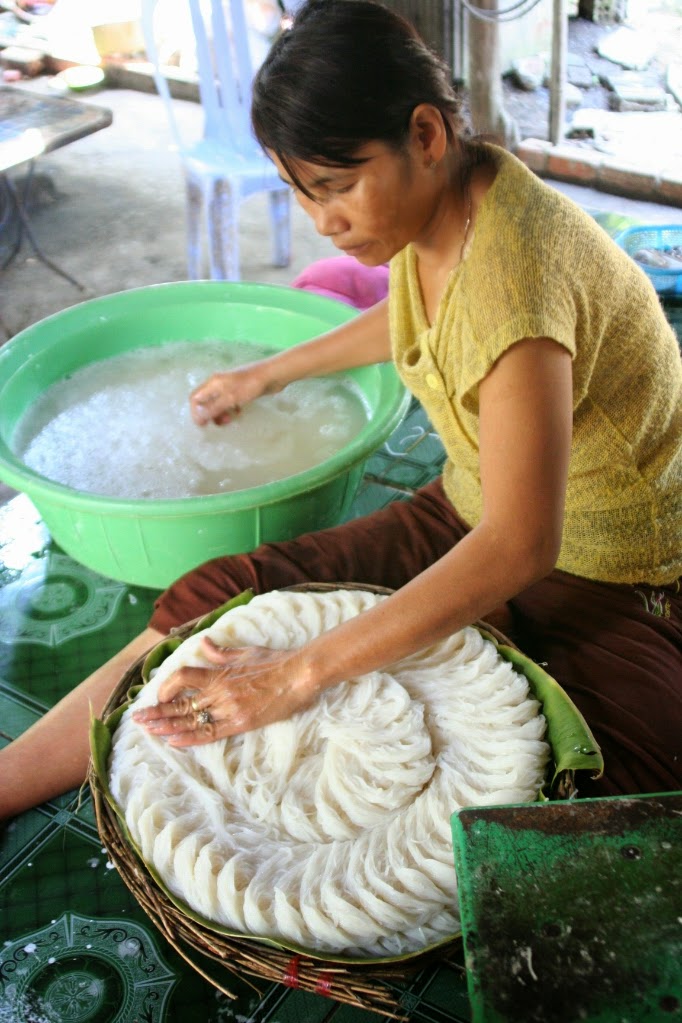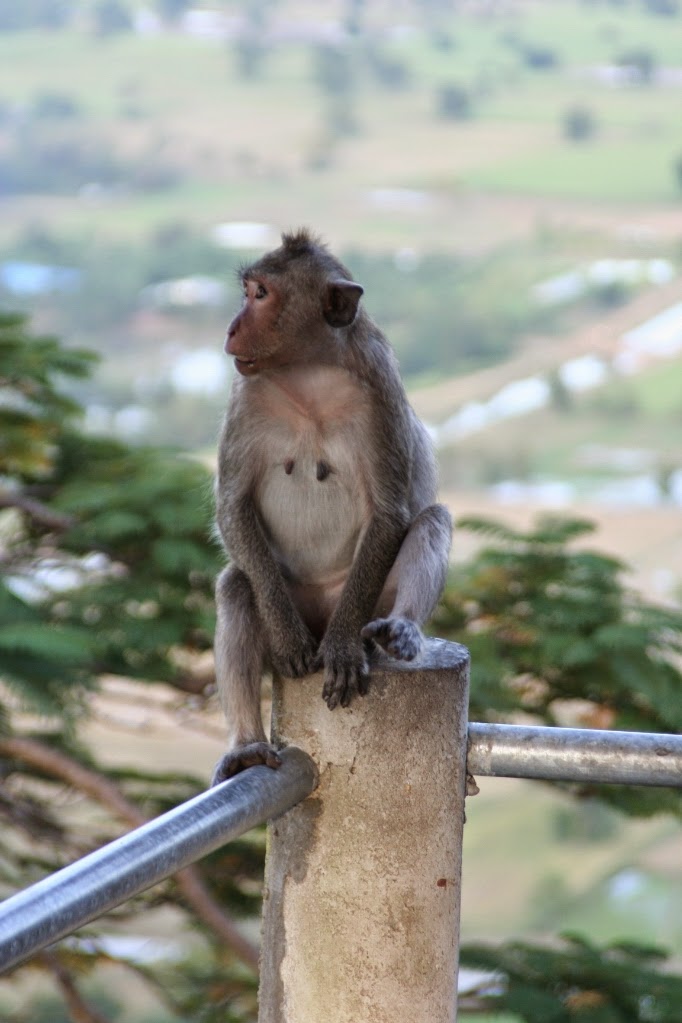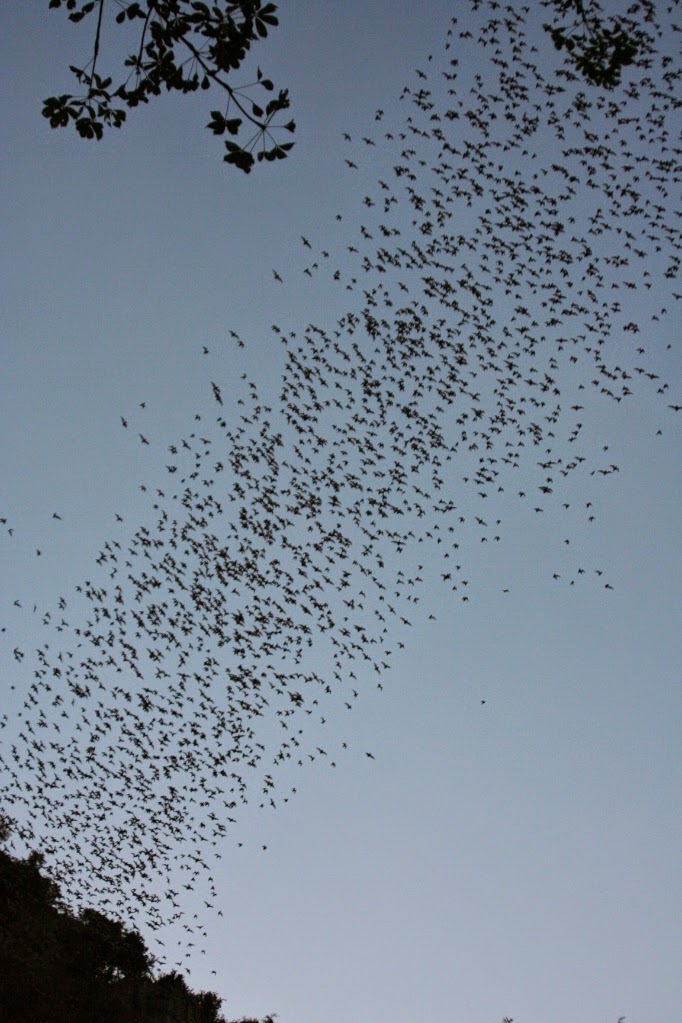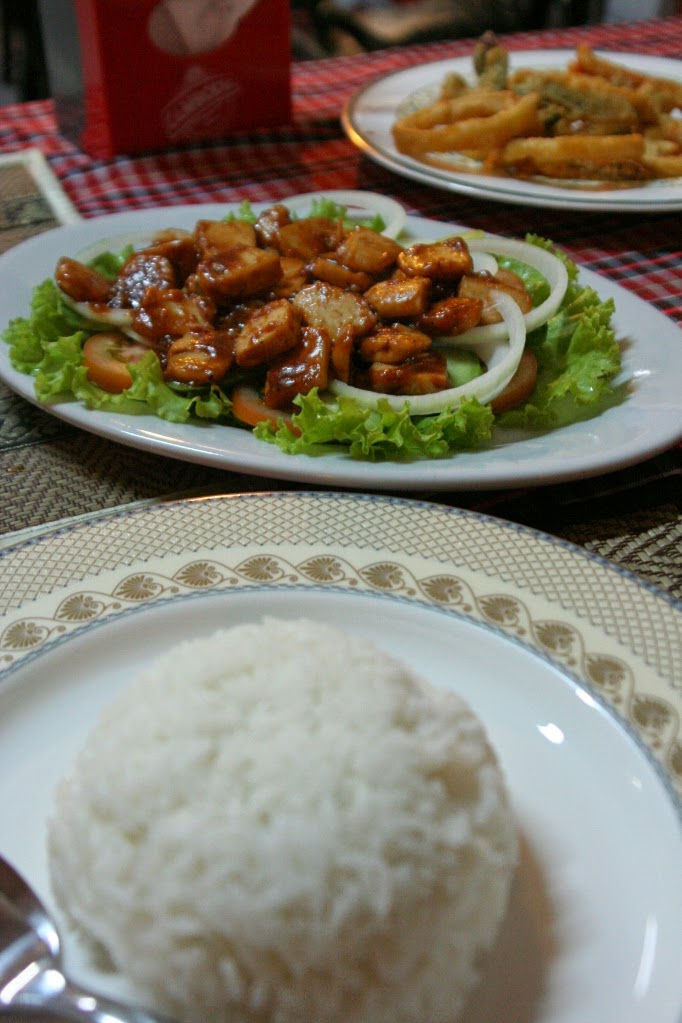We started to the north, which is home to many small cottage industries. Along the route, we passed clusters of houses where the families make the same thing. One area might be dedicated to rice paper, while in another there might be a string of noodle-makers. Whether the families share equipment or know-how, I'm not sure, but it's possible that they simply start in the trade they see their neighbours plying.
We stopped at a house where a couple were agreeable to our taking a look at their set-up. As we arrived, bamboo lattice frames were propped up in the front yard covered in discs of rice paper drying in the hot sun. A man was busy stoking the fire fuelled by a hopper of rice husks, providing steam to a piece of stretched cloth over which a lady spread a smooth rice paste. Once steamed, which took only a few moments, the round rice paper was transferred onto a piece of tubing, and rolled onto the bamboo lattice for drying.
While we observed the process, the couple filled several of these frames. The paper is used by families and restaurants alike for fresh spring rolls. They have a rustic irregularity when compared to the rice wrappers of Vietnam, which are factory made. There are no such factories in Cambodia and so packets of perfectly circular 'bánh trang' are imported.
A short way along the road brought us to a cluster of houses, outside of which thin layers of banana were drying on narrow bamboo shelves. Inside one such house, a husband and wife team had a similarly industrious collaboration, in which the wife sliced razor-thin slivers of banana by hand with a knife, layering them onto wooden trays. These were carried away by the husband to dry, creating a semi-sweet banana 'paper' loved by children.
The hardest and hottest work had to be in making rice noodles used in the dish num banh chok. Having soaked and puréed the rice, two boys fed the resulting white dough into a mould. Using both their weight, they pressed the paste through the holes using a long wooden lever, the extruded noodles cooking instantly as they came into contact with the boiling water below.
The noodles were washed and layered into an attractive pattern on banana leaves by two ladies. The noodles are sold fresh and do not last longer than a day. The team works tirelessly every day to provide noodles for the community.
Along our route, we also passed the fish market, where they make stinky prahok (fermented fish paste). Unlike the sweet smell of bananas or the attractively patterned layers of rice noodles, the putrid tubs of fermenting fish matter being forked over by one of the workers didn't inspire me to eat the final result. Two little girls sat on the floor, expertly chopping the heads from the fish with sharp cleavers. This they do between morning and afternoon lessons at school and seemed well practised. We moved on rather more quickly from this place.
Ek Phnom is an 11th century temple that is replete with 'Danger' signs. Unlike the temples of Angkor, little or no restoration work has been undertaken here and so we clambered into the site over fallen stones and under the two halves of a cracked lintel leaning on each other. Inside, the sandstone blocks are piled precariously, tipping over at alarming angles with only the weight of the stones pressing down to hold them together. The whole structure gives the impression of a giant game of Jenga, in which removing a single block might reduce the temple to a dusty pile of rubble. It was a tense but exhilarating investigation of the inner sanctum.
Heading south of Battambang, we reached the bamboo train line. Once used to shuttle goods between towns faster than by ox and cart, but rendered redundant by the use of motorbikes and trucks, a section of the line remains open for tourists only.
The 'train' comprises a bamboo frame only slightly sturdier than those we had seen used for drying food products this morning, two axles, and a motor that drives the rear axle. We sat cross-legged, each on a cushion, as though on a flying carpet. The driver started the motor and climbed on the back. Accelerating, we were soon at top speed and the countryside whipped by, a shuddering jolt going through us as we went over the joins in the track that had been warped in the hot sun. The train offered nothing to stop us falling off as we flew over bridges and through level crossings.
 |
| Weight-lifting Battambang style |
It wasn't long before we met opposing traffic on the single track. In a complicated dance of yielding priority, the drivers of the two trains carefully dismantled one of the vehicles to allow the other to pass. Having switched places, we continued our journey on the newly assembled train. At the far end, there was just time for a cooling coconut before the return journey.
Taking the road west to Phnom Sampeu, we visited two different kinds of caves, and made the climb to the summit, where an impressive monastery is situated.
After a late lunch of fried 'Chinese' rice noodles (the wide flat kind) at the foot of the hill, we set off up the incline.
Some way up the side of the hill, there is an opening known as the 'killing cave'. Looking up from inside the cave, one can see a skylight, through which enemies of the Khmer Rouge regime were thrown, having been butchered and bludgeoned to death. Alongside the recovered bones of the deceased is a large reclining Buddha, built to honour the victims.
Phnom Sampeu is an aberration in the otherwise largely flat plains surrounding Battambang, and affords a wonderful view over the patchwork green fields dotted with trees in one direction and out towards the border with Thailand in the other. Our guide had told us to beware of naughty monkeys that sometimes turned violent. His advice was to carry a stick and wave it in front of us, which K duly did, but the macaques were mostly benign.
Descending once more to ground level, as the sun began its own descent, we were just in time for a stunning display at the 'bat cave'.
In a cave on a largely inaccessible side of the hill, a huge number of bats sleep during the daytime hours and, around dusk each day, make a spectacular exit.
As we gaped skywards, uncountable numbers of the creatures streamed forth from the rock, silhouetted against the rapidly darkening blue sky. The exit lasted tens of minutes, indicating that they must number in the millions. Not flocking like starlings, rather snaking and twisting out into the distance like a dragon, the bats venture miles to feast on insects before returning.
We followed the trail of bats in the tuk-tuk, like storm chasers. The sun was setting, painting the sky pink, purple and orange. The bats rose from the top of Phnom Sampeu like a plume of smoke and gradually dissipated.
Back in Battambang, we had dinner at Ambrosia Café. This offered vegetarian versions of Khmer and Western food, so we ordered tofu lok lak and salt and pepper tofu. The latter was properly peppery, while the former was served in a rich tomato sauce with a garlicky dipping sauce.
Tuesday nights are classic movie nights at Ambrosia, which meant that we also enjoyed a showing of Raging Bull while we ate. 'Enjoy' might not be the operative word, as it is a harrowing tale of a man who had it all and destroyed it through violence.















No comments:
Post a Comment